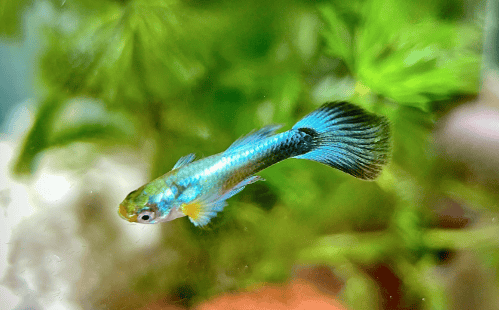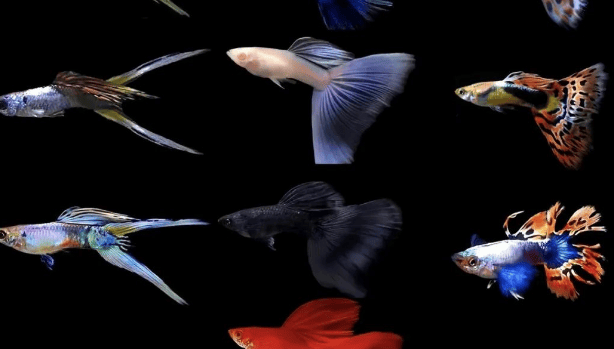Since the goldfish caught from the amusement park unexpectedly lived for a season last year, my family has begun to gain confidence in fish farming. In addition to raising goldfish, I also bought guppies and started breeding them. On the road to fish farming, you are stepping into pitfalls and gaining relevant knowledge at the same time. Here are some introductory guides, hoping to help you get through the novice phase quickly. Without further ado, let’s start with the guppy ecological breeding guide.

Guppy Introduction
Guppy is a common tropical ornamental fish native to the freshwater basins of South America. But it can also live in a semi-salt water environment. It likes water temperature between 12 and 26 degrees. The optimal temperature is between 25.5 and 27.8 degrees. It generally lives in hard water and has a slightly alkaline pH (pH7 to 7.5). environment of. It can also live in semi-salty, estuarine environments. (This information comes from Wikipedia)
The fun of raising guppies
1. Gorgeous appearance. Guppies are colorful and gorgeous in appearance, with a variety of bright colors and patterns, such as red, blue, orange, purple, etc., which are very beautiful and attractive. A variety of guppies 2. Lively temperament. Guppies will quickly shuttle through the water, swing their fins, chase and display themselves. These active behaviors can bring people viewing pleasure. We can put some porous ornaments in the fish tank to facilitate guppies to hide and play. 3. Strong reproductive ability. Guppies are ovoviviparous. What is ovoviviparous is that they lay eggs inside the body and hatch them inside the body. When the female guppy gives birth, we can see the baby fish falling from the lower abdomen one by one. A female fish can give birth to dozens to hundreds of fish at a time, an astonishing number that can overwhelm the tank in one year. It should be noted that if the female fish is hungry when giving birth, she will eat her own baby fish. If you want the baby fish to have a high survival rate, you need to put the female fish in a production isolation box.
Producing isolation boxes
How to distinguish between male and female
You can usually distinguish between male and female by looking at the body shape and color. The size of female fish is 1.5~2 times that of male fish. , the abdomen is rounded, the overall color is lighter, and the tail spread is small. The male fish is brightly colored, has a slender body and a wide-spread tail. Guppies that are less than 2 months old generally have no color yet, and the male and female fish have the same body shape, so it is difficult to tell the male and female by their body shape.
Ecological fish tank
To provide a comfortable living environment for guppies, ecological fish tank is an ideal choice. First we need to understand what an ecological fish tank is. Ecological fish tanks, as the name suggests, are fish tanks that simulate the natural environment ecosystem. It usually contains a variety of organisms such as fish, aquatic plants, and microorganisms that interact to form a balanced ecosystem.
Benefits of ecological fish tanks
First, health. Provide a stable fish living environment for ornamental fish and keep the water quality clean for a long time. Second, worry-free. There is no need to deal with fish feces, and no need to change the water frequently (if the system is stable, it may not need to be changed for more than a year).
How the ecological fish tank system operates

Understanding the system operation of ecological fish tanks is beneficial to us in the process of raising fish. , discovering problems can effectively solve them. Fish tank ecological diagram Fish: The main inhabitants of the ecological fish tank, they need oxygen to breathe and produce feces (ammonia). Aquatic plants: Provide habitats and hiding spots for fish, absorb carbon dioxide through photosynthesis, release oxygen, and use inorganic matter to grow. Microorganisms: Convert feces and food residues (ammonia) into inorganic substances (nitrite and nitrate) to promote ecological cycles in water bodies. Through this system operation relationship, we can reason about the reasons behind the occurrence of problems and find solutions. When the water is turbid, we can check whether there are too many feces or food residues, and we can clean up the feces or reduce the feeding amount. It may also be that the ecosystem is not complete. You can add some nitrifying bacteria to the fish tank to help the entire ecological cycle.
Fish tank layout
Fish tank
Try to choose a square fish tank, because a round fish tank will make the fish look deformed or twisted, which is not conducive to viewing, and the circular arc will produce The light will damage the fish's eyes. In addition, it will cause visual distress to the fish and affect their perception of the surrounding environment.
Water
Tap water, drinking water, or mineral water can be used for breeding guppies. Drinking water and mineral water can be used directly, while tap water needs to be left to dry for two days to allow the chlorine or other disinfectants in the water to evaporate (chlorine is harmful to fish). When raising fish, you must first raise water. On the one hand, raising water is to volatilize the disinfectant in the water, and on the other hand, you must also raise the invisible bacteria in the water. If the healthy growth of beneficial bacteria can be ensured, water quality can be kept stable and healthy to a large extent. We can make some adjustments to speed up the growth of beneficial bacteria: add salt or potassium permanganate for disinfection when adding water to a new fish tank; add nitrifying bacteria after placing bottom sand and aquatic plants. If the water in the fish tank needs to be changed, first clean up the waste in the fish tank, and then add water with a temperature similar to the temperature of the fish tank. Do not feed within 6 hours after changing the water.
Bottom sand
The first choice for bottom sand is volcanic stone. The volcanic stone is porous and conducive to the survival of microorganisms. It can also effectively absorb fish feces and food residues to keep the water clear. If aquatic plants are cultivated in a large area, aquatic grass mud can be spread on the bottom.
Aquatic plants
First of all, don’t buy aquatic plant seeds, and don’t ask me how I know (laughing awkwardly). There are no seeds for aquatic plants, so you can buy the plants directly. Most aquatic plants need aquatic plant mud to provide nutrients. If you don't want to lay aquatic plant mud (the aquatic plant mud will cause a bad experience when turning over the tank), you can directly buy aquatic plants with aquatic plant mud lumps, and they will grow and survive after being put into the tank. Heating rods with aquatic plants are used when the temperature is low in autumn and winter. If they are kept indoors and have heating, floor heating or air conditioning at home, they can maintain a suitable temperature, so there is no need for heating rods. When using a heating rod, be sure to read the instruction manual. Generally, the entire heating rod is completely immersed in the water. Improper use may cause explosion and leakage, and the fish will suffer. The suitable survival temperature for guppies is 22 to 28 degrees. The minimum temperature cannot be lower than 13 degrees, and the maximum temperature cannot be higher than 36 degrees. If the temperature is lower than 13 degrees or higher than 36 degrees, a large number of guppies will die.
Lighting
Guppies need warm-toned light, preferably one that can simulate natural sunlight. The time to turn on the lights can be determined according to the person's schedule. Turn the lights on when you get up in the morning and turn them off when you go to bed at night. Sometimes I get up early to observe guppies and find that they are all still, either sinking to the bottom or resting on plants, or they are still sleeping. In addition, if the lighting time is too long, green algae will easily grow in the fish tank, making it difficult to clean. If the fish tank is on the balcony and can enjoy natural sunlight, there is no need for additional lighting.
Filter and oxygen pump
Neither of these are usually needed. As long as the ecology in the fish tank is stable, the water quality can be kept clear for a long time. The filter also risks sucking away small fish. Guppies have low oxygen consumption and do not need an oxygen pump.
New fish entering the tank
When buying fish online, new fish must first pass temperature and water quarantine before being put into the fish tank. Overheated. Place the bag containing the fish into the fish tank and let it sit for 30 minutes to allow the fish in the bag to adapt to the water temperature of the fish tank. Over the water. Open the bag, scoop out some water from the fish tank, add it slowly, let the fish adapt to the water quality of the fish tank, and let it sit for 10 minutes. quarantine. Quarantine and watering can be carried out at the same time. Drop an appropriate amount of methylene blue/potassium permanganate/oxytetracycline (choose one) into the water and let it sit for about 10 minutes. The purpose of quarantine is to prevent the spread of disease and protect existing fish stocks. After completing this step, you can put the fish into the fish tank. Feeding. Do not feed new fish within two days after they arrive home, otherwise they will die quickly. New fish may experience mild dehydration and nutrient depletion after going through the transportation process. They will also be under great pressure when they arrive in a new environment. At this time, feeding will increase the burden and is not conducive to their recovery.

 扫一扫微信交流
扫一扫微信交流
发布评论